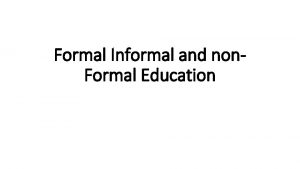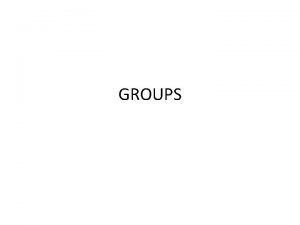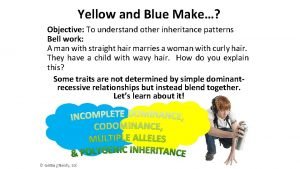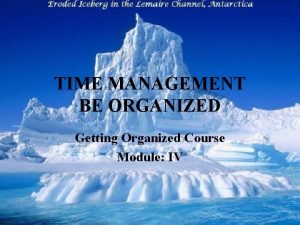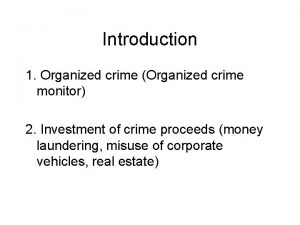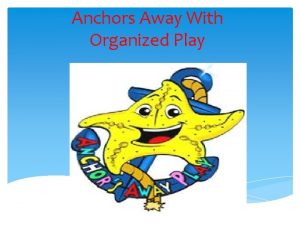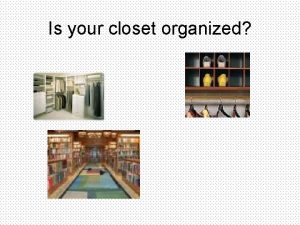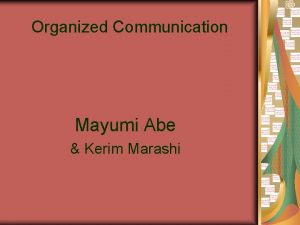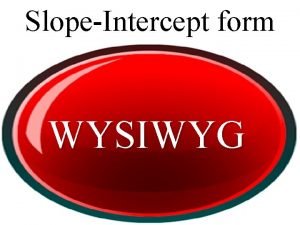Creating a Language Getting Organized Form a group



















- Slides: 19

Creating a Language: Getting Organized • Form a group of 4 -6 individuals – Give the group a name • Exchange contact information with your group members. (c) Harriet Ottenheimer

Creating a Language: Keeping a Project Book • Use a notebook or folder to keep track of everything. – By the end of the semester you should have: • A title page (the name of your group) • A jobs and names page (who did what? ) • An introduction page (general description of the language and the experience of creating it) • One page for each language-creating module • Your final skit, with a translation • A conclusion page (what you have learned about language from this experience) • Be sure to maintain maximum consistency between all of the modules in(c) your notebook. Harriet Ottenheimer

Creating a Language: Jobs and Names • Here is a list of modules and suggested job names: – – – – – Cultural focus (ethnographer) Consonants and vowels (phoneticist) Phonemes, allophones, and conditioning (phonologist) Base forms, affixes, allomorphs (lexicographer, morphologist) Sentences, structure (syntactician, grammarian) Differences, politeness (sociolinguist, discourse analyst, pragmaticist) Kinesics, proxemics (non-verbal communication specialist) Writing system (orthographer, scribe) Change (historical linguist) • It is fine to invent alternative names! (c) Harriet Ottenheimer

Creating a Language: Cultural Focus • Choose a cultural focus for your group – Some previous foci include: • • • Fishing Sports Shopping Eating Drinking Dating – Be creative!. (c) Harriet Ottenheimer

Creating a Language: Consonants • • • Your language will need some consonants Begin by choosing 8 to 12 consonants to use These can be as complex as you wish Be sure you can pronounce each one Use phonetic symbols (use the I. P. A. ) – do not use English spellings • Put your consonant symbols into chart form – use the workbook charts as models. (c) Harriet Ottenheimer

Creating a Language: Vowels • Your language will also need some vowels • Choose between 4 and 6 vowels to use – be sure you can pronounce them • These should be simple vowels • Use phonetic symbols (use the I. P. A. ) – do not use English spellings • Put your vowel symbols into chart form – use the workbook charts as models (c) Harriet Ottenheimer

Creating a Language: Phonemics • Assume each of your sounds is a phoneme • Now create a pair of allophones for one phoneme: – Choose one phoneme and create a variant • OR – Convert two phonemes into allophones of one • Your allophones should resemble each other – same manner or place of production, e. g. • Create a rule to describe the distribution of the two allophones. (c) Harriet Ottenheimer

Creating a Language: Base Forms • Use the sounds on your charts to create: – 9 -12 thing words • visible body parts, movable items, parts of the room… – 4 -6 action words • sit, stand, give, touch, open, close, lift, put down… – 6 -8 descriptive words • size, color, number… – 2 -6 people words • you, me, I, we, he/she/it, you/y’all, we two, we three. . . – 2 -5 “function” words • the, a, this, that-over-there, in, at, on, under (c) Harriet Ottenheimer • Be sure you can pronounce your words.

Creating a Language: Affixes • Now add to your base forms by creating: – an affix to derive one kind of word from another • e. g. things from actions, or actions from things – an affix to inflect one kind of word • for example: – – – gender: male, female, neuter. . . number: single, plural, dual, triple, inclusive, exclusive… shape: flat, thin, round, square, oblong, 3 -D, floppy. . . time: now, soon, never, always, yesterday, tomorrow… validity: witnessed, heard about, heard from reliable source… comparison: strong, stronger, strongest. . . – Remember to only use sounds in your charts!! (c) Harriet Ottenheimer – Be sure you can pronounce your words.

Creating a Language: Allomorphs • If there’s time and you feel ambitious: – develop a pair of allomorphs for one of your morphemes – develop a rule to explain where to use each allomorph. (c) Harriet Ottenheimer

Creating a Language: Sentences • Using your words (base forms & affixes): – Create a simple declarative sentence type • Decide on word order – SOV, SVO, VSO; adjective + noun? noun + adjective? – Using your declarative sentence • create a negative OR an interrogative sentence type – – – insert a word add an affix change the order of words change the intonation etc • (you can create both if you want to). (c) Harriet Ottenheimer

Creating a Language: Structure • For each of your sentence types: – Show the structure using slots and fillers • AND, if there is time, and you are feeling ambitious: – Show the structure using trees (and rules) • In each case, give examples. (c) Harriet Ottenheimer

Creating a Language: Difference in Action • Identify some different linguistic situations – formal/informal, teasing/serious, • And identify a ‘difference’ in your group – male/female, Senior/Junior, major/non-major • choose a way for your language to index (mark, indicate, signal) these differences – degrees of loudness? – Specific words only used by one group? – Specific words only used in certain situations? (c) Harriet Ottenheimer

Creating a Language: Politeness • Taboo a word – Choose an existing word from your lexicon • You will never be able to use it again – Develop a reason for tabooing this word • Create a euphemism for it – Choose another word from your lexicon – Or create a new word which suggests the tabooed word • It should sound different from the tabooed word – Develop an explanation for why this euphemism ‘works’ • Create a greeting • Create a farewell. (c) Harriet Ottenheimer

Creating a Language: Kinesics & Proxemics • Create two or three gestures: – friendly, obscene, teasing, aggressive, etc. • Create a proxemic system – define degrees of space: • • Intimate Personal Social Public. (c) Harriet Ottenheimer

Creating a Language: Writing (optional) Create an orthography for your language. (c) Harriet Ottenheimer

Creating a Language: Change • Borrow a word from another group – visit, send someone, invite someone……. . • • • What word did you borrow? What does it mean? Why did you borrow it? Can you pronounce it correctly? How does it affect your language? – Phonology, new concept, …. . . (c) Harriet Ottenheimer

Creating a Language: Presentation • Prepare a short skit in your language • Your skit should include: – – A greeting A request or command for someone to give/do something to someone A use of your tabooed word (and its euphemistic substitute) A farewell • Be sure to use your proxemic system in your skit • Be sure to use your kinesic system in your skit • Once your skit has been presented, present it again in English, so your classmates can follow along • Then please present a very short summary of the key features of your language for your classmates. (c) Harriet Ottenheimer

Creating a Language: The Final Product • Turn in your notebook for grading – There should be: • A title page • A jobs and names page (who did what? ) • An introduction page (general description of the language and the experience of creating it) • One page for each language-creating module • Your skit, with a translation • A conclusion page (what you have learned about language from this experience) • Remember to maintain maximum consistency between all of the(c)modules in your notebook. Harriet Ottenheimer
 Getting ahead
Getting ahead It is intentional organized and structured form of learning
It is intentional organized and structured form of learning Interrogative form present continuous
Interrogative form present continuous Groupthink vs group polarization
Groupthink vs group polarization Within group variance vs between group
Within group variance vs between group Anova within group and between group
Anova within group and between group Social group examples
Social group examples Group 2 specialties
Group 2 specialties How to compare thermal stability of group 2 nitrates
How to compare thermal stability of group 2 nitrates Amino group and carboxyl group
Amino group and carboxyl group Amino group and carboxyl group
Amino group and carboxyl group In group out group
In group out group Group yourself or group yourselves
Group yourself or group yourselves Sumner's classification of social groups
Sumner's classification of social groups Joining together group theory and group skills
Joining together group theory and group skills Yellow and blue make
Yellow and blue make Getting acquainted with the vehicle
Getting acquainted with the vehicle Getting a driver's license illegally may result in
Getting a driver's license illegally may result in The fur coat setting
The fur coat setting Nerdy frog
Nerdy frog

